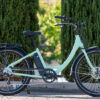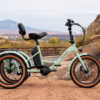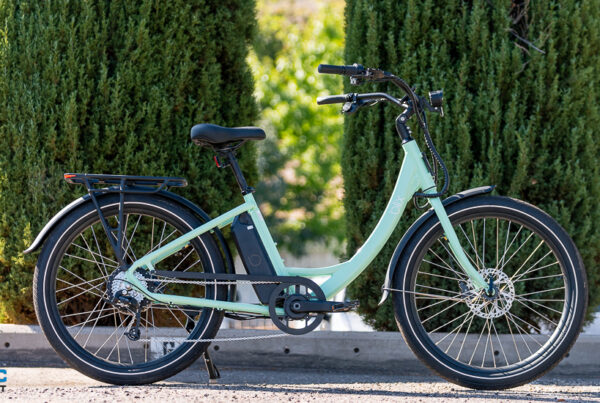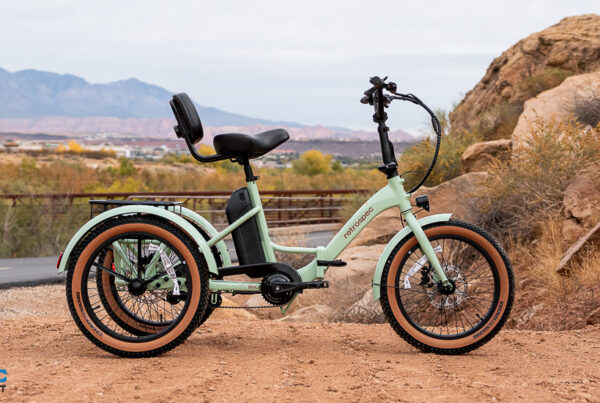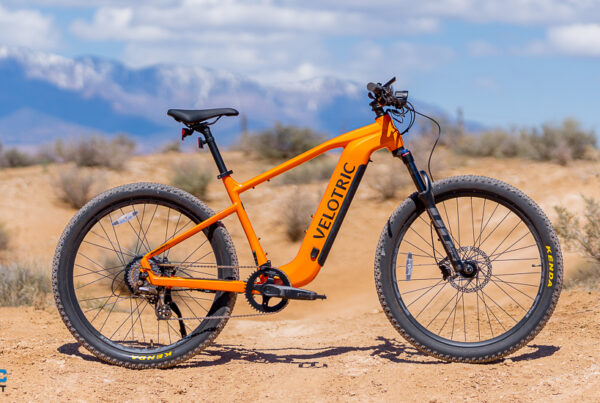The Velotric Nomad 1 features a 48V, 750W Velopower (Velotric’s proprietary design) rear hub motor with cadence sensors, which is driven by a single chainring and an 8-speed cassette. Its large motor is appropriate for a heavy, fat tire e-bike with some off-road capability, and its cadence sensors require only an easy quarter-turn of the cranks to trigger the motor.
A word of caution: the initial acceleration boost that occurs here can be somewhat alarming, especially in tight or obstacle-filled areas where a high degree of control is desirable. The rear hub motor can also take some getting used to, as it produces the sensation of being pushed from behind. Neither quality is uncommon in an e-bike, but may be surprising to those who are more used to traditional bicycles.
We were initially skeptical of the proprietary Velopower motor, but after reaching out to Velotric for more information about it, our concerns have been put to rest. It turns out that while the drive system was designed by Velotric (who has a team of highly experienced, proven developers), the motor itself is made by a reputable manufacturer with ties to Lime and Segway. Our contact at Velotric elaborated on their motor, saying “the Velopower drive system uses a custom temperature control circuitry, material composition and winding scheme which increases the efficiency of our range, torque, and speed compared to similar motors in our price class (most notably, BAFANG, which powers so many of our direct competitors). It’s the reason why you’ll see our range is longer compared to our direct competitors despite the sleek integrated design.”
When testing the Nomad 1 on our test circuit (see the graphic above for a more detailed explanation of the trial), I was able to get a thorough feel for the increasing effect of the bike’s 5-stage pedal assist system. As a 200lb rider with no cargo, the stages ranged from almost no noticeable effect at PAS 1 to nearly effortless speed with the assistance level set to PAS 5.
With no pedal assist (PAS 0), the weight of the Nomad 1 is very apparent. As a fat tire e-bike weighing 72-73 lbs, this is completely expected; trust me when I say that you don’t want to be caught pedaling one (especially uphill) without assistance from the motor. In PAS 1 and 2, the motor provides a slight boost that can primarily be felt on an incline. PAS 3, however, is really where things start to feel significantly improved both on flat ground and on hills.
The 4th pedal assist setting felt to me like the Nomad 1’s “sweet spot”, offering both smooth and easy travel on the flat and plenty of assistance on uphill paths. This level still allowed me to get a bit of a workout if desired, but also kept me moving at a quick pace when I wanted to relax and rely more on the motor.
In PAS level 5, I felt like the motor almost completely took over, requiring only a casual degree of input to keep the cadence sensors feeding the motor. This setting also kept me at or around the Nomad 1’s maximum velocity even when traveling uphill.
As a Class 2 e-bike, the Nomad 1 has a top speed of 20 miles per hour, and offers both pedal assistance and a throttle. When relying only on the throttle, the Nomad has a couple of useful and greatly appreciated features. First, the PAS system is tied in with the throttle, and can be used to govern speed. PAS 1 is set to 10 mph, with 2-3 mph increases per level up to 20 mph at PAS 5. Second, the Nomad’s brakes have a cutoff switch, so even if the throttle lever is being pushed, any application of the brake lever will stop the motor from driving the rear wheel.
In our testing, the Nomad 1’s motor performance, speed, and acceleration felt on par for its specs and class. A 750W motor should provide plenty of acceleration and uphill capability, and the Nomad had no problem with either (see the Hill Test section for more details there). I also appreciated the flexibility granted by the 8-speed drivetrain, despite being unfamiliar with its brand.
This brings up one final point specifically regarding the Sunrace Megadrive cassette. This brand is not one we have much experience with, though it is Shimano and SRAM compatible. The cassette we tested performed adequately, but we cannot speak to its longevity and reliability over time.
Source link



